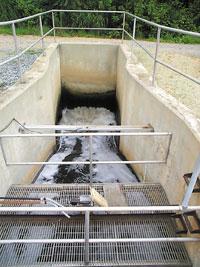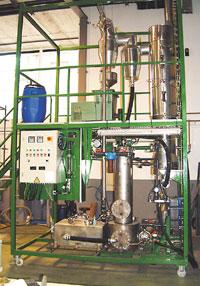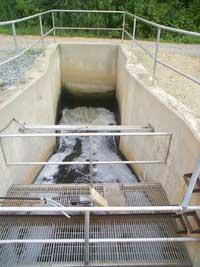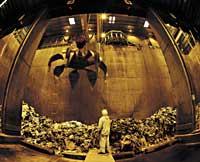Cleaning sludge
2003/05/01 Andonegi Beristain, Garazi - Elhuyar Zientziaren Komunikazioa Iturria: Elhuyar aldizkaria
For this reason, priorities are currently established in waste management. First, waste generation should be reduced and subsequently reused and recycled. Finally, when it is not possible to perform all the above steps, it is necessary to obtain and eliminate raw materials and energy from waste.

Since all these steps are necessary, the waste disposal is sanctioned by the loss of resources contained in the waste.
In fact, in most urban, agricultural and industrial waste there is organic matter, water and other resources. From these resources, energy can be obtained through different methods, such as electric energy from organic matter. This includes pyrolysis, incineration and gasification.
Pyrolysis is the thermal decomposition of organic matter in an oxygen-free medium. Incineration is the complete oxidation of waste at high temperatures. Finally, in gasification, solid or liquid fuels become gaseous fuels, that is, a solid or liquid fuel becomes gas.
Sewage sludge gasification
The INASMET technology center is developing gasification prototypes. In this case, these are prototypes for the treatment of sludge purifiers, although this technology is also useful for other types of waste.
The choice of gasification of sewage sludge has its cause. According to the new European legislation, all municipalities of more than 5,000 inhabitants must have water treatment plants in the short term or in a nearby municipality. In the Historical Territory of Gipuzkoa itself, due to this legislation, it is expected to open new facilities with the consequent increase in the amount of sludge. In fact, more WWTP will generate more sludge.

Another consequence is the treatment of these sludge. However, the new legislation also limits the amount of sludge water and the amount of organic matter, mainly due to the problems generated in the treatment plants. Therefore, in the treatment of sludge it is important to remove most of the water they contain and recycle the organic matter contained in the sludge. Therefore, the water treatment plants to be implemented in the municipalities should take these measures into account in the treatment of sludge.
Sludge drying and gasification
Most sludge concentrates on water, specifically 90-95%. Mechanical treatment of this water is currently used in all treatment plants, but the results are not desired. Therefore, a plan has been put in place to replace these systems with heat treatment systems. The new plan will eliminate mechanical treatments and establish heat drying systems. This eliminates more water from sludge and provides a solid waste containing only 15-20% water.
After the maximum drying of the sludge, it is gasified, as is the case of the prototype of fluid bed of Inasmet. In it, the sludge is gradually introduced into a bed of sand around 800-900°C. This bed of sand has a height of one meter and makes it circulate through the air that passes through it.

It is precisely the high temperatures and the air that evaporate the organic matter and the water that contain the sludge and, therefore, that produce the gasification. In addition, at all times the amount of oxygen in the chamber is controlled to prevent combustion.
Gasification produces mainly carbon monoxide and hydrogen, but in addition to these gases carbon dioxide, methane and water vapor are obtained. All of them form a group of gases suitable for combustion, very useful for obtaining energy, such as heat or electric energy.
This is another possibility offered by gasification: in addition to treating sludge, it produces an energy-exploitable raw material. In addition, the implementation of other processes can result in obtaining high purity hydrogen from gasification, which can be used for the production of fuel cells. On the other hand, it should not be forgotten that the heat treatment systems that are implemented in the treatment plants will increase the consumption of electric energy, and if obtained from the gasification plants, the energy balance of the treatment plant will be balanced.
www.ihobe.net
Gasification processes Gasification technologies are still in development phase, depending on the waste one method or another is used. As for technology, it can be said that there are two main gasification methods: fixed bed and fluid bed methods. The bed is the bed or base on which gasification occurs, so there are those with fixed bed and fluidized beds. Fixed bed gasifications are used for thermal applications, i.e. for heat generation. In fact, in this type of gas it is difficult to obtain clean gases at the end of the process. The fluid bed, on the other hand, is used in most cases to generate electricity. This is the prototype being developed at INASMET. |

Gai honi buruzko eduki gehiago
Elhuyarrek garatutako teknologia






